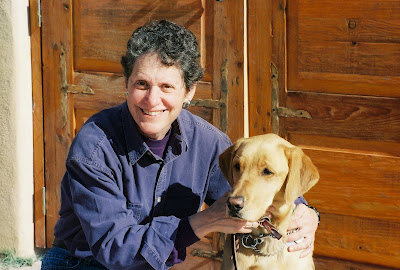 The following is an excerpt from
The following is an excerpt from"Traveling Blind: Adventures in Vision with a Guide Dog by My Side"
by Susan Krieger
I am blind and I am sighted. I am often not sure of what I see. Do I see what is there? The images look so small. People on the street at any distance seem tiny to me, with thin legs that disappear in the shimmering sun. Often the people themselves disappear if they are not in my direct line of sight. Cars on the street also look tiny, like toy cars in the distance. Up close, however, they appear so large that I must take them in piece by piece: a part of a fender, the blue oval emblem that says “Ford.” Though I can no longer read the brand names, I still play the game of guessing at the makes of the cars as Teela pulls me quickly past them.
Walking down the street with her, and everywhere I go, I feel self-conscious. People see me with a large dog and they notice me. Sometimes they think I am blind and being guided by Teela. Other times they think I am sighted and training her for someone else who is blind. The uncertainty of how I am perceived makes me anxious. I must emotionally navigate my identity at the same time as I physically navigate my route.
The contradictions abound for me. For instance, I do not see well, yet I keep trying to; I look around intently with my eyes. My vision is impaired, yet I enjoy my sight. When I step outside with Teela and I am wearing my dark glasses, I am overjoyed by the images that come in through the tinted lenses by bright contrast– a white edge of a house, a light tree trunk reflecting the sunlight, a set of large bright letters against the dark background of a store awning. Although the letters look bent and broken to me, and as if they are underwater, glowing with a phosphorescent shine, to me they are beautiful, magical. I stare at these letters and I think, “I can see.” It takes many internal steps, much going over in my mind, to remind myself that I take such joy in seeing the letters precisely because I can’t see, or can’t see well. Objects that have some clarity come through the hazy confusion in front of my eyes and make me happy.
As I walk farther down the street, I pause to stare at a stop sign ahead. The letters on the sign’s red background waver and disappear, then come into focus; I study them with my right eye, then my left, testing my vision, as I often do—trying to determine the exact state of my sight. Which eye is better now? Which sees with more of an edge? Has my vision changed since I last looked at this sign? I continue walking past pieces of sharpness, sections of buildings and streets. I know what I am looking at generally, but if I did not, it would seem a jumble.
Traveling in my familiar neighborhood in San Francisco, much like my more distant travels, is like being in a movie that I perceive in separate frames that do not flow smoothly into one another. In this choppy movie, I focus on what lies straight ahead, trying to make it out. A small figure down the street may be a child or a dog. I tilt my head, using the different parts of my eyesight in an attempt to bring the figure into focus, though it will only become clear closer up.
Teela, stopping, points her nose toward a square object farther away. Odd-looking at a distance, it turns out to be a wheelchair that someone has left on the sidewalk. I stand beside it and examine the arm rests and wheels, taking them in one section at a time, much as I do when using a magnifier. Maybe I’ll remember what a wheelchair looks like from a distance when I next see one.
I pass the child and I wonder why I thought it was a dog. Why am I always seeing dogs? Perhaps because I overlay new objects with memories of familiar ones, making assumptions until I find out what is really there.
As I walk, deciphering the world—guessing at and identifying the different pieces of it—I am constantly thinking about what I see, and by this I mean not only what an object is, but what it means to see it. Does seeing a child the way I do, or seeing a person’s thin shimmering legs in the distance, mean I am sighted? Does it mean I am blind? What does what I see say about who I am? Questions about my identity always lurk for me behind the more practical questions about what lies before me.
Listen to Susan's presentation to the Commonwealth Club and to her radio interview on "To the Best of Our Knowledge".
No comments:
Post a Comment